As someone who lives in Marseille told me, “Marseille is a way of life”. It’s the playing of pétanque (similar to bocce), the imbibing of pastis (an anise liqueur developed in Marseille as a substitute for the banned absinthe in 1915), the savoring of Bouillabaisse (for which Marseille is famous), and a certain “joie de vivre”. It is also a way of life that embraces the diversity of this melting pot on the Mediterranean and its rich culture, history, and art — giving an ample number of reasons for its designation as a 2013 European Capital of Culture.
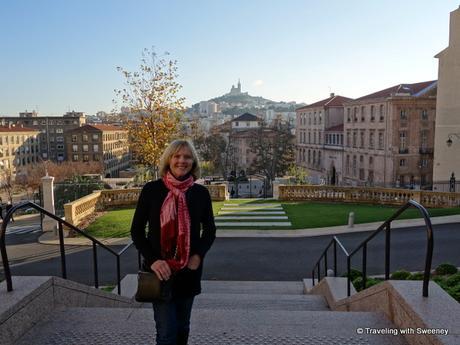
Arrived in Marseille! Beautiful backdrop of Marseille’s Eiffel Tower, Basilica Notre Dame de la Garde from the steps of the InterContinental Marseille Hôtel Dieu
We arrived at Gare de Saint-Charles by the TGV high-speed train (about three hours from Paris) with few preconceived ideas of what to expect in France’s oldest and second largest city, the first stop on our tour of Provence. After checking in to the InterContinental Marseille Hôtel Dieu, we quickly got started exploring the city and its art, heritage, and architecture.
In 1995, the Euroméditerranée Project launched redevelopment programs in the city. Further renewal projects coinciding with the City of Culture designation have brought about many positive changes in Marseille. We saw some of them as we got our introduction to the city.
Our favorite highlights of Marseille
Vieux Port
First, we headed down to the Vieux Port (Old Port) for lunch. Bistros and brasseries line the perimeter, but one of the first we came across beckoned us with wine, steamed mussels, and frites. In a part of France that enjoys 300 days of sunshine each year, it was a lovely sunny afternoon for savoring the feel of a Mediterranean coastal city, even with a bit of a December chill. Although there were a fair number of people about, it was a quiet scene, compared to how I imagine the crowds and the vibrant activity in summer.

The Old Port of Marseille
After lunch, we walked further along the port to the Place du Général de Gaulle, where a large ferris wheel towered over the Christmas market filled with seasonal items as well as textiles, crafts, food and drink. It was also the location of the Foire aux Santons, the annual fair showcasing santon (“little saint”) figurines, a key element of Provencal Christmas traditions.
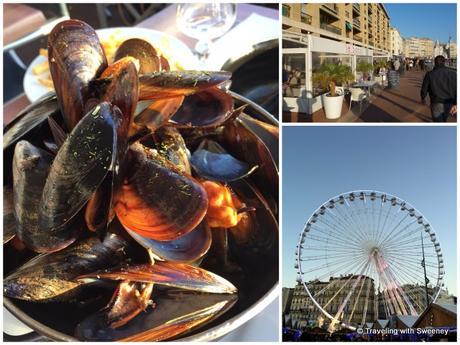
Steamed mussels for lunch along the Quai du Port, Foire aux Santons ferris wheel
Place Daviel
There is significant history in the area adjacent to the Old Port on Place Daviel, named after Doctor Jacques Daviel who performed the first cataract extraction in the mid-18th century at the Hôtel Dieu (now the InterContinental Hotel on Place Daviel where we stayed). The Pavillon Daviel was originally the Palais de Justice (courthouse) where in times past sentences were read from the wrought-iron balcony above the guillotine in the square. It’s now an annex to the Hôtel de Ville (Town Hall) on the Quai du Port. Pavillon Daviel was built in the mid-18th century with the beautiful pink stone from the quarries of Cap Couronne, about 25 miles from Marseille.
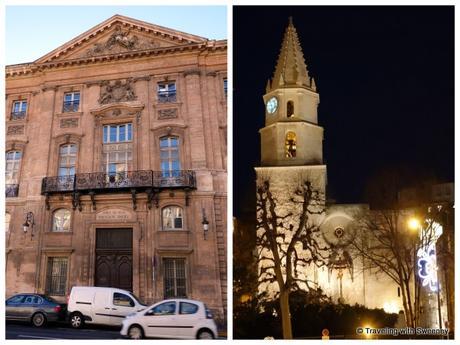
Left: Pavillon Daviel Right: Accoules Church
Just across the Grand Rue, a remaining section of the the street first built by the ancient Greeks, is one of Marseille’s oldest landmarks, the Accoules Church. It stands on the site of the original 6th century church. The bell tower goes back to the 13th century, but the rest of the church was rebuilt after being destroyed during the French Revolution.
Le Panier
Marseille is a melting pot with immigrants coming from all over the world, many settling in Le Panier since ancient times. One of the oldest districts in France, it was first settled by the Greeks in 600 B.C. whose name for the city was Massalia. In early times, immigrants came mainly from Italy and Corsica.
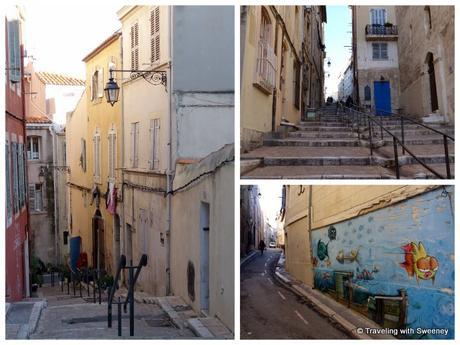
The streets of Marseille’s old district, Le Panier
I love old historic districts like Le Panier (named “the basket” because it was the location of the marketplace) where you can sense the ancient history as you walk up and down the narrow stepped alleyways. Le Panier has seen positive changes due to the Euroméditerranée Project, while retaining its distinctive character.
The Mistral (a strong wind common to the region that blows a sustained 40 km/hour and can reach 100 km/hour) was picking up as we stopped to look at the shops, cafes, and galleries along the way. Some of the galleries have been established in recent years, often by Parisians who visited and fell in love with Le Panier and became part of its rapidly growing artists’ community.
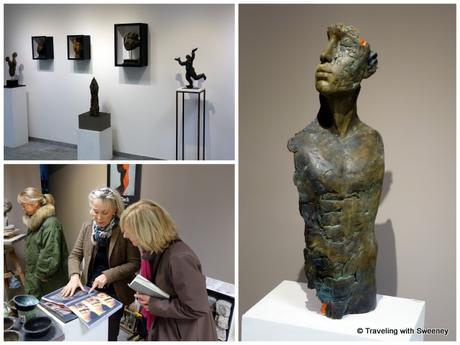
With Lisa Deck in her gallery in Le Panier
We met Lisa Deck, a sculptor who moved to Marseille from Paris, in her gallery on Montée des Accoules and she was very gracious in talking to us about her work. As we walked further along, we found a diversity of artistic expression in murals and in the galleries, such as Atlelier Celadon where ceramics, mosaics, and glassware are featured (photos on right below).
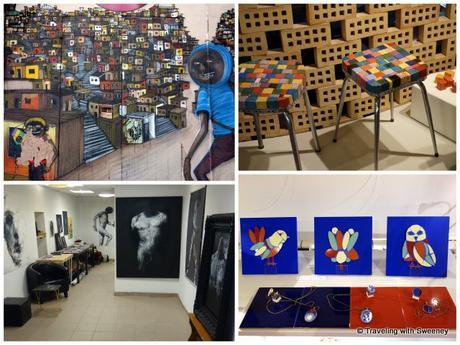
Diversity of art expression in Le Panier
Many buildings captured my attention with their colorful facades, old-world character and decorations. In the morning hours of our tour, some shops, cafes and bars were not yet open, so it was quiet throughout the district and we saw very few of its 6,000 residents.
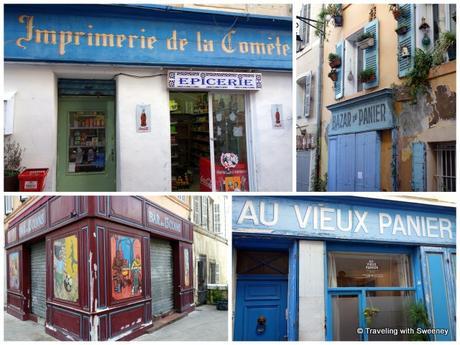
Colorful facades of Le Panier
A very popular French television program, Plus Belle La Vie, takes place in a fictional part of old Marseille. Although it’s actually filmed at studios north of Marseille, French tourists enjoy seeing the Bar des 13 Coins (shown above, bottom left), on which the show’s fictional café is modeled. In the photo bottom right is Au Vieux Panier, an art-centric small hotel in a 17th century building that was once a Corsican grocery store.

Place des Moulins, Le Panier
As the Mistral continued to whip around us, it was easy to see why the Place des Moulins was the appropriate place for the 15 windmills (moulins) that were once on this square in the late 16th century. It is on the highest hill of the old district and the winds seemed especially strong here. By the 19th century when water became the main power source, only three of the windmills remained. Their foundations can still be seen (two are shown in the photos on the right above).
Vielle Charité
This particularly stunning Baroque structure also has a surprising history.

La Vielle Charite, Marseille
Vielle Charité was conceived in 1622 (construction began in 1671 and was completed in 1749 due to funding availability) by the city council to be “the great confinement of the poor”, a place to house beggars and the poor, but in later times served other purposes as a hospice for the elderly and army barracks. The architect was Marseille-born Pierre Puget who is also renowned for his works originally in the gardens of Versailles. It’s a stunning complex, particularly the long arched corridors of the four buildings that surround the courtyard and Italian baroque oval-domed chapel.
It’s interesting that the famous architect Le Corbusier is responsible for saving the Charité from being demolished after World War II. Now as a listed historic monument, it is a cultural center with museums, a bookshop, and a tea room.
On the waterfront
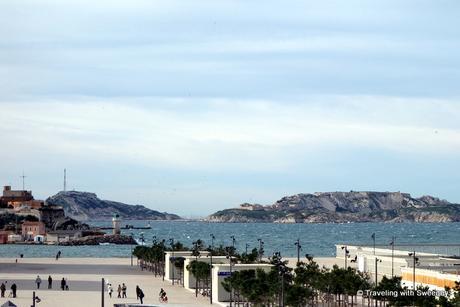
Esplanade on the waterfront of Marseille
Much of Marseille’s redevelopment due to the Euroméditerranée project and the impetus for change that was the Capital of Culture designation are especially apparent on the waterfront and the cultural area which was once deserted La Joliette docks.
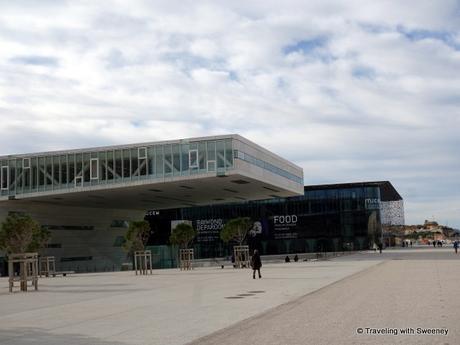
On the waterfront, Villa Mediterranee and the MuCEM, Mareille
Facing the waterfront are these two intriguing architectural gems on the esplanade.
Villa Méditerranée
The cantilevered structure, Villa Méditerranée, was established as a center for international dialogue, research, and cooperation. It has a striking design by Italian architect, Stefano Boeri. What you don’t see from outside are the three below-ground levels which house a concert hall and cinema for Mediterranean-based films.
MuCEM
Just beyond it, it the MuCEM (Museum of European and Mediterranean Civilizations) also epitomizes the contemporary Marseille in its own unique design by architect Rudy Ricciotti. It’s the first French national museum to be located outside of Paris. Its exhibits reflect the richness and diversity of Mediterranean civilizations and it offers performances, concerts, films and other events.
I loved walking up the ramp that continued around the building from bottom to top. The latticework exterior design allows you to take in framed views of the Mediterranean, the cathedral, and other parts of Marseille through its openings. The MuCEM also has a restaurant on the top floor which has received much acclaim — Michelin-starred chef Gérald Passédat’s Le Mole Passédat. Also at the top is a walkway connecting the museum to the historic 17th century Fort Saint Jean.
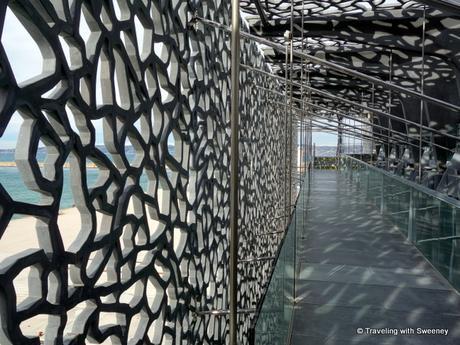
Intriguing latticework design of the MuCEM exterior
We didn’t have time to go through the MuCEM, but as we strolled along the exterior walkway, we got glimpses of the history and heritage exhibits inside.
La Major Cathédrale (Marseille Cathedral)

La Major Cathédrale, Marseille
I was really taken with the picturesque waterfront landmark, La Major Cathedrale (Sainte Marie Majeure) and its gorgeous and unusual Byzantine and Romanesque design. It took forty-one years to build it (for various reasons, including economic) from 1852 to 1893.
Fondation Regards de Provence
Also nearby is the Fondation Regards de Provence, another museum that opened in 2013. Located in an old sanitation station, it was the first stop for immigrants entering France in Marseille. There is a 45-minute film that explains the history of the building and you can actually view the original drying ovens where the clothes of the immigrants were sanitized as soon as they arrived in port. The museum’s galleries include paintings, sculptures, and photos from the 18th century to present reflecting Marseille’s artistic, cultural, and musical heritage.
Tip: There is a very good restaurant in the building with lovely port and coastal views where we enjoyed a delicious lunch. Although it was early afternoon, eager to start my Provençal experience, I indulged in my first and only pastis.
Hotel InterContinental Hôtel Dieu
The 5-star InterContinental Marseille-Hôtel Dieu was actually a bonus highlight of our stay in Marseille. Overlooking Place Daviel, it stands on the site of the 12th century Saint-Esprit Hospital which was merged with the Saint-Jacques de Galice hospital in 1593, expanded by adding wings in the 18th century, and then transformed to a teaching hospital in 1993 before closing its doors as in 2013. This is the place where Doctor Daviel, mentioned above, performed his ground-breaking cataract surgery.
After renovations and new additions on each of the wings, the InterContinental was opened in 2013, more evidence of the significant changes in Marseille.
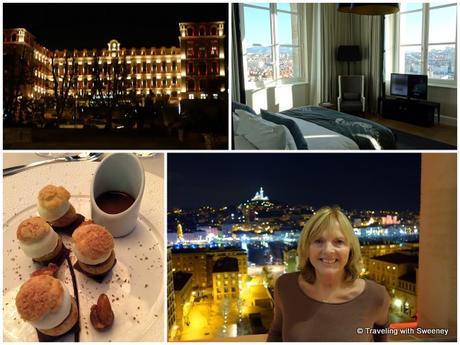
Intercontinental Hotel Dieu: Prestige Suite views, dessert of Profiteroles Hôtel Dieu at Les Fenêtres
We were upgraded to a very spacious Prestige Suite that included a separate living room, dining area, and over-sized bathroom. From the large French windows in each room, we had spectacular views of the harbor, the city, and most stunning, the Basilica Notre Dame de la Garde. The location is perfect for experiencing all of the highlights we enjoyed. It’s also less than 10 minutes by taxi from Gare Saint-Charles railway station.
We also enjoyed our dinner at Les Fenêtres, the hotel’s brasserie with an intimate ambiance. Our entrees of salmon and duck were creative and delicious, topped by Profiteroles Hôtel Dieu with vanilla ice cream for dessert (shown in the photo). Service was attentive and friendly both at dinner and at the gourmet breakfast buffet, also served in Les Fenêtres.
The top of Marseille
From our first moments in Marseille, we had our sights set on going to the top of the city, La Garde, to visit the Basilica Notre Dame de la Garde and see the views.
Tip: From the old port, you can walk (about 45 minutes), take the tourist train (Le Petit Train), or take the 60 bus. We were going to take the tourist train because I’m sometimes a sucker for those things, but were told that they were done for the day (not enough tourists). So we took the 60 bus and I’m so glad that we did. There were other tourists on board, but mainly we were surrounded by locals. It made the trip much more interesting.
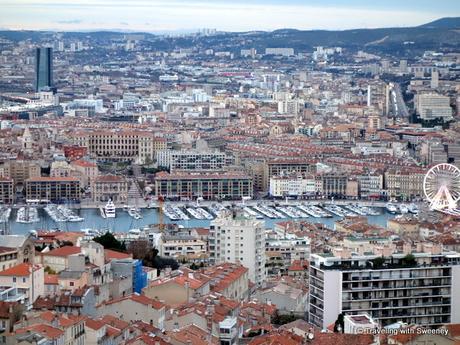
View of Marseille from the highest point in the city
The views in every direction are amazing. In the upper left of the photo above, you can see the CMA CGN shipping company headquarters, a skyscraper designed by Lebanese architect, Zaha Hadid, and the Joliette business district below it.
Basilique Notre Dame de la Garde
La Garde is topped by the 19th century Basilique Notre Dame de la Garde, often referred to as Marseille’s “Eiffel Tower”, which can be seen from many vantage points in and around the city. (Such as in the top photo of this post.)
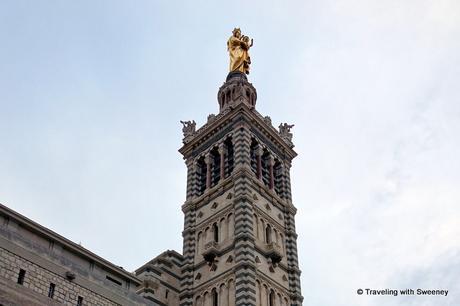
Basilique Notre Dame de la Garde
Inside the neo-Byzantine basilica, a mass was in progress, but we were able to capture a glimpse of the gorgeous décor. The boats hanging from the ceiling are in honor of sailors and fishermen and to represent their safety at sea.

Basilica Notre Dame de la Garde
Arriving in late afternoon enabled us to enjoy a spectacular sunset enhancing many of the vistas.

View of the Iles du Frioul and sailboats on the Mediterranean
I’m sure that the views from La Garde are beautiful at any time of day, but we were glad that we were there to see the spectacular sunset. As the sun set, the skies just got more and more colorful creating an unforgettable memory of being at the top of Marseille that evening.
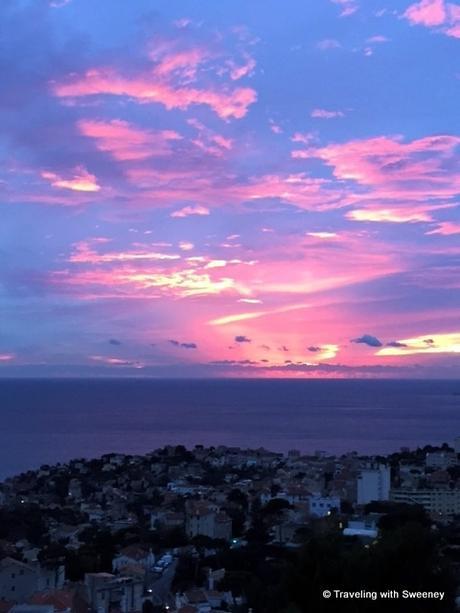
Sunset over the Mediterranean Sea
À bientôt, Marseille. — See you soon, Marseille.
We’d be back in Marseille (actually near the airport about 20 miles outside of the city) on our final night in Provence before flying home. But in the meantime, there was more of Provence to see. Stay tuned.
For more information about planning a visit to Marseille: Marseille Office of Tourism
This article originally appeared on Traveling with Sweeney.

